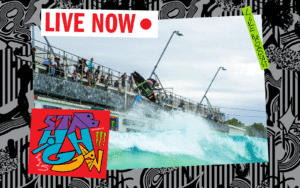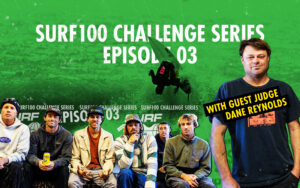Style: A Thing Of The Past Or Just Temporarily On Hold?
With Taj Burrow, Conner Coffin and shaper to the style gods, Mark Rabbidge.
There is a line of thought going around certain sections of the surfing community that the unique personal styles and individualistic flair that once made the sport great are on the way out. In the interest of preserving what has historically been a mainstay of surfing culture – the vast array of individual interpretations to riding a wave – we engaged three of the most knowledgable brains on the topic Taj Burrow, Conner Coffin, and Mark Rabbidge to discuss.
Vintage style master and original hi-fi superstar, Taj Burrow
“(Style) is kind of everything when you’re growing up. Pretty much every surfer that started at a young age would look at their favourite surfers and try and emulate their style. A lot of people take it more seriously than others. I used to rewind video sections and copy arm placement and everything. And I think most groms do that today still. Everyone wants to surf like their favourite surfer,” he says.
Taj’s style influences consisted of a who’s who of iconic style-maters, including Curren, Occy and Slater, all of whom he had the privilege of watching at their zenith as a kid.
“I went through a few different people. I really liked Tom Curren a lot, and Kelly when he was in his late teens-early twenties. He was my favourite, he was the guy. I used to rewind and copy everything when I saw Kelly Slater In Black and White. I just melted that thing in the VCR. Further down the track I really liked Occy and I really, really liked Shane Dorian for a number of years there. His hand placement is probably the one I copied the most. In small rippable rights, I used to just freak out on him. Occy it was his backhand that got me excited.
“And Curren, I just loved his style, especially on his forehand. He just looked so good on a wave even if he was going straight. And then when he leans into a big frontside carve his style was just my favourite, I loved it. For Kelly it was more so what he was doing on the wave, getting his fins out, and tail slides, when all that stuff started happening I freaked out.”
He agrees that board design is a deciding factor in the development of unique and functional style.
“Boards determine how you surf…Obviously the boards we grew up on were a lot longer and narrower. In my opinion I almost liked that look a bit better. I think they make turns look bigger and I think they were really cool,” he says.
“Boards are probably aimed toward being a lot more user friendly these days. But I think with the longer, narrower boards back in the nineties they looked sick when you could get them working. I guess they just had more of a sweet spot, not as forgiving as boards these days. I think when all the pros and all my favourite surfers were surfing at their best on those boards it looked insane,” he says.
Modern style master, Conner Coffin
“Style means something different to everyone,” says Conner. “It’s an expression of you and an extension of whatever you feel and have going on, so to be able to surf how you’re feeling that is cool.”
“Everyone has a different style but I guess something I’ve always picked up on in surfing are the movements and stuff in between. Obviously everyone’s doing turns and airs and stuff, but the way it all flows together into one whole big package, to try to connect it together in a smooth way, always made sense to me. Growing up surfing point breaks, my favourite surfers were Tom (Curren) and Taylor (Knox), Andy (Irons) and Dane (Reynolds), those guys always had a lot of style in different ways. I just respected the fact they all made it their own and just kind of expressed themselves so that was something I was inspired by and wanted to make a part of my surfing.”
“Style is a product of your environment and attention to detail is also what it comes down to. You’re looking at the manoeuvres but you are focusing a lot on little minute things in the middle of those that some people might not give a shit about. To me it always made sense. Everyone just grows from where they surf I think. I’ve grown up surfing point breaks so that’s just kinda what you did. Even people who weren’t pro surfers, just local surfers, style still mattered. I remember one old guy was like, dude, you don’t hop, you use as little movement as possible to surf the waves.
“Boards also have a huge part to do with it. Not many people know this about me but I grew up longboarding until I was eight years old. My uncle longboarded and a couple of my friends, and that’s what I did. And then I really liked single fins. When I wasn’t on a longboard I had this single fin spoon thing that I would ride and even when I started riding a shortboards I was riding like a 6’0 for a long time when I was a little kid and could have been riding something a lot smaller. When I was short boarding a lot more, Al (Merrick) and the people involved with Channel Islands and a lot of people close to me always encouraged me to ride more boards. You’re drawing longer, smoother lines by riding a bigger board and I felt like longboarding and single fins taught me that. That a huge part to do with it. Julian was a really good longboarder growing up too and he’s got that nice polished really smooth rail game and I think that when you ride those sorts of boards, especially single fins, you have to work with the wave, you can’t just go all over it.”
Shaper to the style-gods, Mark Rabbidge
Australian shaper Mark Rabbidge knows a thing or about style. It was his board that Tom Curren used to ephemeral effect on a J Bay wall back in 1993 in what is still considered the most stylishly surfed wave of all-time (it was a 6’6″x18 1/4 x 2 5/16 if you’re interested).
“I remember when I first saw that footage I went yep, that thing does nothing wrong! It was just cool the way it went through the wave,” he says, adding, “the little things shapers look at aren’t big turns. It’s the little subtleties, the between the moves stuff and that thing did it really sweetly.”
Name a style master from the eighties or nineties and Rabbidge has probably made boards for them. Mark Occhilupo, Sunny Garcia, Curren and many more sought his decades of experience and craftsmanship. Rabbidge himself was a professional surfer during the 1970s (if you can call them that. No one was making an easy living off riding waves in those days), a period he recalls as unique in the fact that those at the top end of surfing performance were also shapers and designers.
“When I used to compete as a kid and you lined up on the beach to go surfing there might be me, Nat (Young), Jack Ladder, Col Smith from Narrabeen.”
“Each one of those guys was a shaper and designer and we were all developing the surfboard back then and we all had different concepts of what was right,” he recalls.
Having spent more than fifty years in the upper echelons of surfing, first as a surfer but more enduringly as a shaper (he is still in regular contact withe the likes of Darren Handley while his wife Pam Burridge, whom he made many boards for, won a world title in 1990), he is well placed to offer a critique on surfing today. Significantly, Rabbidge laments the loss of the iconic personal styles of yesteryear at the expense of progressive manoeuvres and what he believes is uniform board design.
“What’s happened over the years the ASP or WSL or whatever it’s called now has determined surfboard design more than anything else and it’s through surfers trying to gain points.”
“For years they’ve all tried to look the same and be better at being the same and I think a lot of that has come from the likes of Cheyne Horan in the past who were stigmatised for riding equipment that was a little bit different to what everyone else was riding,” he says.
“You can debate whether Cheyne was ahead of the curve or flogging a dead horse. Personally I thought he should have won a world title. Back then he was surfing totally different to MR (Mark Richards, twin-fin champion and four time world title winner) and MR took a lot off him but I think Cheyne’s ability was as good if not better and I think he was penalised because of the way he looked when he rode the wave.
“The design of a surfboard comes around what scores ASP points. Back in the day it was four waves to the beach, so surfboard design was such that you could catch plenty of waves on the bloody thing and not fall off. You used to get scored for length of ride. Then you go through history and it changed a lot. You had to have two majors out the back and it didn’t matter about length of ride so surfboard design changed again.”
“Nowadays you have two waves and the priority system so surfers can score against each other up in the air. Once again surfboard design has been moved in a direction that enables surfers to score points in the ASP so therefore it trickles down into what everybody else rides, but mate people can’t ride ‘em,” he laughs.
In his day, when boards were still hand shaped by master craftsman, the philosophy was very different.
“I shape boards for people, right. I don’t make models and go, ‘here y’are a new model,’” he says.














Comments
Comments are a Stab Premium feature. Gotta join to talk shop.
Already a member? Sign In
Want to join? Sign Up